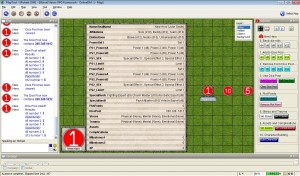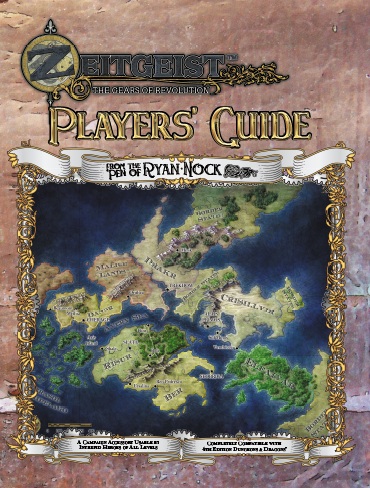So, the big news announcement on January 9 was indeed about the next iteration of Dungeons and Dragons. Lots of folks have been chiming in with their thoughts; here are mine.
Modularity
Wizards of the Coast has said that they want the game to be modular, offering groups the chance to have more complex or less complex games as they see fit. It’s a lovely notion, and if they can pull it off, I think it will help to make the game appealing to a wide audience.
I expect to see options for omitting things like opportunity attacks. I expect to see a wizard option that’s Vancian and a wizard option that has at-wills. I expect to see separate books for whatever the next iteration equivalent of tiers will be (heroic, paragon, epic), with big changes between them.
Open Playtest
The other big news in the announcement was that WotC would be engaging in an open playtest of the rules. A friends and family playtest is ongoing (and no, so far your OnlineDM does not rank highly enough in the D&D community to have been invited; pity). The first public viewing of the current version of the new rules will be at the D&D Experience convention in Fort Wayne, Indiana, in a couple of weeks (under non-disclosure agreements from the players involved). A wider public playtest is supposed to start sometime this spring.
I’m very happy to see that WotC is making this move. I opined a couple of weeks ago about the importance of the company focusing on good community relations as they move forward; so far, so good. Actively soliciting feedback from everyone who offers it is a good idea. Obviously, they won’t be able to take everyone’s feedback, since some of it will conflict. But at least giving everyone a chance to be heard is a powerful step in the right direction.
Unification
This new iteration is explicitly intended to appeal to players of D&D from its entire history. WotC is trying to unify the D&D community with their new game. A lot of folks have moved to Pathfinder or OSR games, and WotC is trying to interest them in this new iteration.
It’s a tall order. I was shocked to see the level of vitriol on a bunch of OSR blogs on the day of the announcement. I understand that these folks don’t like WotC, but wow. It seems like this company is reaching out to them, and they’re just not interested at all in many cases. There are definitely folks in the OSR who are open to the idea of this new rule set, but I was shocked to see how many flat-out are not at all interested. So, not an easy task for WotC.
What I’d like to see
I’d like WotC to use a game license that lets third party publishers get their content into whatever electronic tools they develop. I find it annoying, for instance, that my players can’t add the ZEITGEIST themes to their characters in the Character Builder.
I’d like to see continued strong support for online tools like the Character Builder.
I’d like to be able to get PDFs of adventures at the very least, and preferably PDFs of everything for the game. I run games using my computer, and I’ve actually gotten to the point where I scan my hard copies of adventures like Madness at Gardmore Abbey so that I can use them more easily as PDFs.
I pray that we don’t go back to Linear Warriors, Quadratic Wizards. And if such a class option exists, I pray that it’s an optional rule that isn’t present for organized play events.
I want magic items to be rarer and more interesting. Mordenkainen’s Magnificent Emporium is the right paradigm. “Expected treasure by level” is not.
I’d love for WotC to make more use of the digest format for books, as they did with Essentials.
I certainly hope the new version keeps the 4e style of monster stat blocks, with everything right there rather than making the DM look up spells and so on. I like being able to run combat easily. Heck, monster creation in general in 4e is fantastic; stick with that!
I want great community outreach. As I said, I think they’re already doing a good job on this one. Keep it up!
What I expect to see
I expect a license that’s more restrictive that the OGL but less restrictive than the GSL. I also expect WotC to do more work with third party publishers to keep them in the loop farther in advance on this issue. Community outreach!
I expect to see Vancian spellcasting in certain classes and probably even Quadratic Wizards in those classes. Sigh. I hope they’re optional rather than the default.
I expect to see the traditional hardcover format books rather than digests. Not a big deal to me, but I’m guessing this will be important for bringing back players who’ve left. They probably don’t want digests (but it’s worth asking to find out).
I expect the PDF issue to be worked out, somehow. They’ve got to get past the “no electronic books” issue if they’re going to have wide appeal these days.
I expect some option for stripped-down rules that won’t require electronic tools in order to build a character, and more advanced rules that basically will.
I expect options for gridless combat to have actual support.
I expect more focus on exploration and adventure and less focus on combat in the core books. Combat will still be well-covered, but the meat of the text will try harder to evoke a sense of wonder.
I expect lots and lots of changes throughout the process. I expect things to come up in the rules that people HATE, and for those things to subsequently go away or become marginalized. I look forward to this.
What about my own games?
I realize that it’s possible that the new version of D&D will be something that appeals to me less than 4e does, in which case I’d probably keep playing 4e. But I expect that WotC will do a good job with this new game, and that I’ll migrate over in the end.
I can say that as soon as I get the chance to playtest the new rules, I will do so. Hey WotC, you want someone to see how the new rules work in an online game, right? Drop me a line at onlinedungeonmaster@gmail.com!
-Michael the OnlineDM
OnlineDM1 on Twitter






